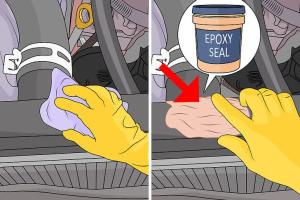Ultimate Guide to Sealing a Leaking Radiator: Step-by-Step Solutions

-
Quick Links:
- Introduction
- Understanding Radiators
- Common Causes of Radiator Leaks
- Diagnosing the Leak
- Temporary Solutions for Radiator Leaks
- Permanent Repair Methods
- Case Studies
- Expert Tips for Radiator Maintenance
- Preventive Measures
- FAQs
Introduction
Radiators play a crucial role in the heating systems of homes and buildings, providing warmth and comfort during cold months. However, when a radiator develops a leak, it can lead to costly damages and diminished heating efficiency. In this comprehensive guide, we will explore how to seal a leaking radiator effectively. We will cover various methods, temporary fixes, and permanent solutions to ensure your heating system operates efficiently.
Understanding Radiators
Radiators are heat exchangers that transfer thermal energy from hot water or steam to the air in a room. They come in various types, including:
- Conventional radiators
- Baseboard heaters
- Steam radiators
Understanding how your radiator operates is essential to diagnosing and fixing leaks effectively.
Common Causes of Radiator Leaks
Radiator leaks can stem from various sources, including:
- Corrosion: Over time, rust can eat away at the metal, causing leaks.
- Loose fittings: Connections can loosen due to thermal expansion and contraction.
- Cracks in the body: Physical damage or manufacturing defects can lead to cracks.
- Valve issues: Problems with the inlet or outlet valves can also cause leaks.
Diagnosing the Leak
Before sealing a leaking radiator, it’s essential to diagnose the source of the leak accurately. Follow these steps:
- Inspect the radiator: Look for visible signs of water pooling or rust.
- Check the connections: Ensure that all fittings are tight and secure.
- Examine valves: Test the inlet and outlet valves for leaks.
- Use a pressure test: This can help identify leaks not visible to the naked eye.
Temporary Solutions for Radiator Leaks
If you need a quick fix to stop the leak until you can perform permanent repairs, consider these temporary solutions:
- Radiator Sealant: Chemical sealants can be poured into the system to temporarily seal small leaks.
- Epoxy Putty: A quick application of epoxy putty can seal cracks effectively.
- Clamps: Using a hose clamp to tighten connections can sometimes stop leaks.
Permanent Repair Methods
For a long-lasting solution to radiator leaks, consider these permanent repair methods:
1. Replace the Radiator
If the leak is extensive and repairs are not feasible, replacing the radiator may be the best option.
2. Soldering
For small leaks, soldering can provide a permanent fix. This requires:
- Draining the radiator
- Cleaning the area around the leak
- Applying solder
3. Welding
In cases of severe leaks, welding may be the solution. This should only be performed by professionals.
Case Studies
To illustrate the effectiveness of different methods, we’ll explore a few case studies:
Case Study 1: DIY Radiator Repair
A homeowner discovered a small leak in their baseboard radiator. They followed the temporary solution of using epoxy putty, which successfully sealed the leak for over six months until they could replace the radiator.
Case Study 2: Professional Soldering
Another homeowner had a small leak in an older model radiator. They opted for soldering, which provided a permanent solution at a fraction of the replacement cost.
Expert Tips for Radiator Maintenance
To prevent future leaks, consider the following maintenance tips:
- Regularly check for signs of wear and tear.
- Ensure proper installation of all fittings and valves.
- Flush the radiator system annually to remove debris and prevent corrosion.
- Consider using a water softener to reduce mineral buildup.
Preventive Measures
Implementing preventive measures can significantly reduce the likelihood of radiator leaks:
- Monitor your heating system regularly.
- Keep the area around the radiator clear of debris.
- Install pressure relief valves to prevent excessive pressure in the system.
FAQs
1. How do I know if my radiator is leaking?
Look for visible water pooling around the radiator or rust spots on the surface.
2. Can I fix a leaking radiator myself?
Yes, many small leaks can be fixed by homeowners using sealants or epoxy putty.
3. What is the best sealant for radiators?
Radiator-specific sealants are highly recommended as they are designed to withstand high temperatures and pressure.
4. How long does a radiator sealant last?
While it depends on the product, many sealants can last several months to years if applied correctly.
5. Should I call a professional for radiator repairs?
If the leak is significant or if you're uncomfortable making repairs, it's best to consult a professional.
6. Can radiator leaks cause further damage?
Yes, leaks can lead to water damage, increased heating costs, and reduced system efficiency.
7. What materials are radiators typically made from?
Radiators can be made from steel, cast iron, or aluminum, each with its own properties and durability.
8. How often should I check my radiator for leaks?
It's advisable to inspect your radiator at least once a year during routine maintenance.
9. Can I use duct tape to seal a radiator leak?
Duct tape is not recommended as a permanent solution due to its inability to withstand heat and pressure.
10. What should I do if I can't find the leak?
If you can't locate the leak, consider hiring a professional to perform a pressure test and diagnose the issue.
By following the steps outlined in this guide, you can effectively seal a leaking radiator and maintain a cozy and efficient home heating system.